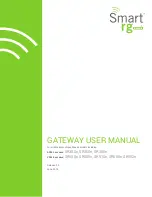
AT Commands
Page 73
REASON NO NAME = <message> where message is ‘Out Of Area’ or ‘Private’ is
displayed if the network does not provide a name
QUAL = Long Distance
is displayed if the call is long distance
REDIRECT = <message>
where message can be ‘Call Forward’ or ‘Call Forward:
First Number Busy’ or ‘Call Forward: First Number
Didn’t Answer’ if the call has been re-directed from
another number.
LOOKUP NAME = ttt..ttt
where ttt...ttt is the name looked up by the modem in its
security database.
CALLBACK NMBR = nnn nnn
where nnn...nnn is the phone number to use to ring the
caller back (which may be different from the number he
dialed in on)
These messages are only available if the Telecommunications Carrier inserts them.
A further option of AT#CID2 is available. This tells the modem to send the entire CALLER ID
message back to the host computer in hex format to allow the host software to decode it.
The modem also supports the following commands:
AT#CID?
Which returns the current setting of the #CID command
AT#CID=?
Which returns the available settings of the #CID
command (0,1,2,3)
Integrating Caller ID into the Security Database
Enter the Security Menu by typing AT#S.
You will then be presented with a request for a Password. If you have not specified a password
then key ENTER, else type in the password.
The Caller ID status is displayed at the bottom of the Security Menu. If Caller ID is enabled
you have the choice of Excluding Callers who are unknown and Accepting Callers who are
unknown by using the ‘T’ command. The T command toggles the option.
To enter a phone number into the security database use the ‘2’ command. The modem will
prompt for the name of the user you wish to identify. Enter the name and then skip the
Password and Options fields by pressing ENTER for each. The modem will ask for a Command
or Phone Number. Simply enter the phone number you want to recognise at this point.
If you wish to identify a range of numbers with the same user name, as in the case of a business
with a large number of phone numbers, you can use the * to match any digit in that position. For
example: 9678 79** will map all numbers from 9678 7900 to 9678 7999.
You may have multiple entries with the same name but different numbers. You are then given a
choice of barring this user by entering the ‘D’ option. If you press ENTER for this option, the
user will always be answered as long at S0 is not 0 and DTR is on.
Summary of Contents for Global Carrier
Page 1: ...Global Carrier 56 Modem User s Guide 0049 2200 001 Rev A...
Page 130: ...Page 130 Range 0 2...
Page 225: ...S Registers Page 225 See Also ATS105Voice Dead man Timer Range 0 255...
Page 252: ...Page 252 Standard RS 232 Examples...
Page 262: ...Page 262...
Page 289: ...Compliances Page 289...
















































